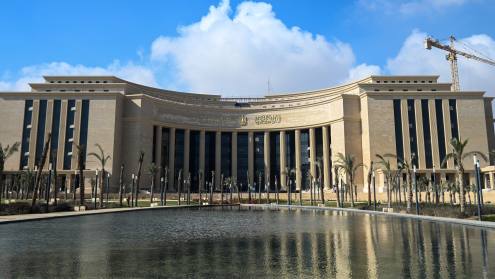In March, queues formed outside Banco Central de Bolivia (BCB), after it announced that it would begin a “direct sale” of US dollars to calm intensifying worries over dollar shortages.
Bolivia’s foreign currency crisis reflects several short-term problems, including the rise in interest rates around the world and higher fuel prices because of the war in Ukraine. But it also stems from long-term problems, including the reduction in hydrocarbons exports.
As of February 2023, Bolivia’s international reserves had fallen to $3.5bn, one of the lowest levels since 2014, when the reserves were $15.1bn.
“The demand for dollars has increased, given reduced public confidence in the ability to sustain the exchange rate,” explains Carolina Caballero, sovereign analyst at S&P Global ratings. “The central bank reacted by strengthening the commitment to sustain the exchange rate.”
Bolivia has had a fixed exchange rate of 6.96 bolivianos to the dollar since 2011, a peg president Luis Arce has pledged will not change.
“The fixed exchange rate was a good idea during buoyant times, but now the population is used to the fixed rate and any signs of currency movement generates panic,” says independent economist Alfredo Seoane Flores.
While issues started to be felt last year, the situation reached a peak on February 8, when the BCB stopped publishing statistics on its foreign currency reserves to supposedly stop speculation.
the population is used to the fixed rate and any signs of currency movement generates panic
This shortage of dollars has been felt by banks and the population, generating a rush to withdraw dollars and then bolivianos with the aim to convert them into dollars. “When the government does not acknowledge the problems, that just makes things worse,” says Mr Seoane Flores.
The economy is expected to grow 3% this year, says S&P Global Ratings, after a rebound of 6.1% in 2021 and contraction of 8.7% in 2020. However, the currency crisis risks destabilising the economy of a country that relies a lot on imports. Importers are at risk of losing contracts as they cannot secure enough foreign exchange to pay or get credit from their business counterparts.
In the long run, as imports reduce and become more expensive, price levels are poised to increase and slow down national output. The monetary supply restriction might also end up generating a credit crunch.
Short-term solutions
On May 5, the Bolivian senate approved the ‘Law for the Purchase of Gold to Strengthen the International Reserves’. This will allow the BCB to purchase gold directly from miners at global prices, in a measure aimed at reducing smuggling.
“The gold law could help for a few months, but if the demand for dollars remains high, and with a tendency to increase due to the adjustment of expectations, it will not be enough,” says Carlos Gustavo Machicado, head of the economics department of the Catholic University of Bolivia.
The problem originates in the state’s inability to control public expenditure, claims some observers. According to this view, it is necessary to reduce the public deficit and find ways to generate foreign currency.
“If the balance of payments was a tub, it would be full of holes allowing dollars to flow out,” says Mr Seoane Flores.
Read more on Bolivia
For many years the country has subsidised the import of gasoline and diesel, with the policy draining reserves. While it would be very difficult for any upcoming government to get rid of subsidies without generating a public rebellion, directing the subsidies to the most vulnerable in society might be a step forward. Reducing support to inefficient state-owned companies could also help contain the public deficit.
“It seems that the government refuses to resort to the International Monetary Fund (IMF), the Latin American Reserve Fund or other institutions that offer credit to alleviate balance of payments problems and replenish reserves, because it knows that these institutions will request a fiscal adjustment,” says Mr Machicado.
He continues: “The BCB is not independent, but subject to fiscal policy, which affects its credibility. Also, by not providing weekly statistics since February, the central bank has deepened the lack of public confidence, which makes it less credible when it claims that deposits are guaranteed and that there is no threat of systemic risks.”
Overdue challenges
What is now a full-blown currency crisis stems from a fiscal deterioration that built up over many years. “The rating downgrades over the past three years have been explained by the deterioration of the external and fiscal profile,” adds Ms Caballero.
Total debt increased from 27.7% in 2014 to 68% last year, according to the UN Economic Commission for Latin America and the Caribbean.
Many point to 2014 as a turning point for the Latin American country, which faced a collapse in the discovery of new gas reserves, as well as a reduction in production and export of the commodity, which had until then supported the country’s growth.
In 2015, Bolivia lost a third of its export revenue following the drop in natural gas prices. In the years since, successive governments have failed to implement economic policy changes that reflect the drop in gas exports. Instead, they tried to compensate with an expansionary public investment programme. Therefore, the adjustment took place at the reserves level.
Reserves in the country had been very high before 2014 following the huge influx of dollars, which allowed the government to reverse the dollarisation of the economy. Before 2006, Bolivia had 80% of financial savings in dollars.
In 2006, Evo Morales came to power and nationalised the hydrocarbons sector. The move expanded the state’s resources massively and spurred growth.
Favourable external conditions also helped the economy. In December 2005, Bolivia, along with other countries, received 100% debt relief as a consequence of the Multilateral Debt Relief Initiative by the IMF. However, problems were looming.
“Public investment increased, but less than current expenditure. These investments did not generate returns in the long term, as there were many inefficiencies in how the investment was deployed. We went from 16 to more than 50 state-owned enterprises. A sugar company was built in an area where there was no sugar, for example,” explains Mr Seoane Flores.
While public investment boomed, private investment did not expand as much and the sectors that benefitted the most during this period were imports and credit consumption, he adds.
Long-term solutions
The so-called ‘New Economic, Social, Communitary, Productive Model’, implemented by then president Mr Morales, was the best thing that could have happened to the country, according to independent economist Miguel Clares. “It generated a relevant growth rate, social change and the economy’s diversification,” he says.
The stable exchange rate has protected the country from imported inflation over the years. It also helped Bolivia overcome a bleak July 1985, when the inflation rate was more than 60,000%.
Gas is now over, so it is now time to develop and invest in lithium production
Now Bolivia is one of only a handful of countries in Latin America that have been able to keep inflation under control. In 2021, inflation stood at 0.9%.
The limited price increase also depends on a number of policy measures. “There is no shortage of products, as the government aims to supply the internal market first and then exports. There are also a lot of measures to avoid price speculation and a zero tariff on imports of capital goods,” adds Mr Clares.
“The neoliberal economic system before 2005 was based on the mantra ‘export or die’ as one president used to say,” he recalls.
For others, Bolivia has – and will always be – an export-oriented economy. “The Bolivian economy has always been somewhat dependent on commodities exports. First with silver, then tin, then gas and now lithium. Gas is now over, so it is now time to develop and invest in lithium production,” says Mr Machicado.
Agro-industrial production could also be explored to support the development of the country. “The soy production in the country could be as important as in Brazil or Paraguay,” according to Juan Antonio Morales, former BCB president.
However, not everyone is convinced the current model is sustainable, both financially and environmentally. Many stress that gold mining has caused environmentally damaging deforestation, with mercury polluting rivers, air and land.
“We should move away from pure extraction of natural resources and towards the diversification of the economy,” says Mr Seoane Flores. “This is only possible with a political change away from the extreme ends of the political spectrum and towards the centre. A state-controlled economy has not proved efficient, but full privatisation is not the solution either.”













